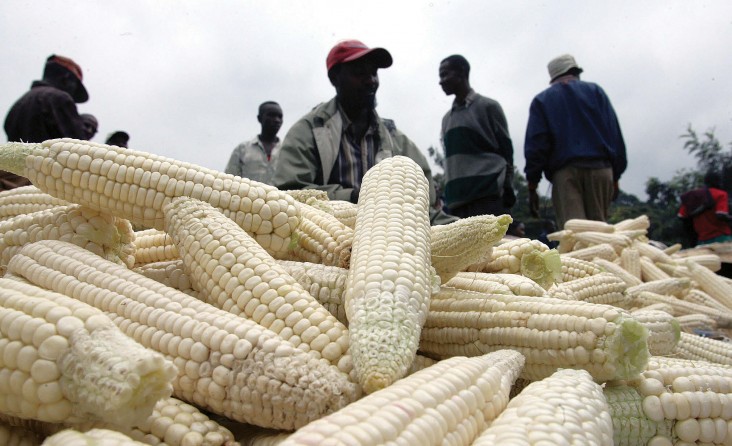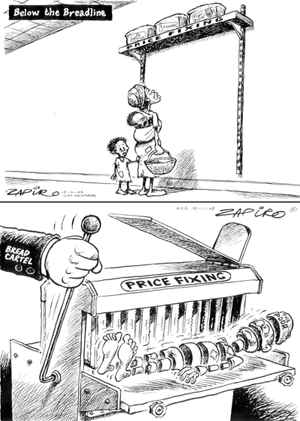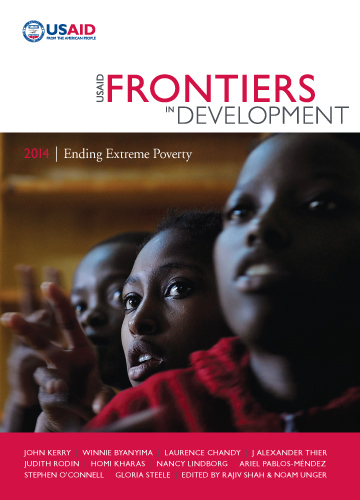Nicholas S. Klissas
“Expect more, pay less” is the catch phrase of Target, one of America’s fastest-growing mass merchandisers. Through innovation spurred by vigorous competition, a sound regulatory environment and good governance, firms like Target benefit consumers by driving competition in the areas of price, variety, accessibility and quality.
Unfortunately, many of the world’s poorest are denied these benefits. Essential goods and services—including the food, fuel, fertilizer, power, medicines, telecommunications and transportation products and services that lie at the heart of many USAID initiatives—easily fall victim to anticompetitive behavior by vested interests. As a result, the poor expect less and pay more.

Economies where vested interests predominate to the detriment of all others represent extractive political systems, described by Acemoglu and Robinson in “Why Nations Fail.” The authors posit that an evolution to inclusive political systems—where robust, responsive institutions freely operate in a transparent, democratic system of governance—can erode the power of the vested interests. Competition agencies, typically government agencies mandated to enforce competition laws and protect consumers, can be an important part of these inclusive systems.
How uncompetitive markets hurt food security
Lack of competition especially disadvantages the poor when it comes to food security. Part of the problem is that the food industry is highly concentrated at both the retail and food-processing levels. Industries that transform crops such as maize into foodstuffs like flour or tortillas are often susceptible to anticompetitive behavior.1

Since poor households tend to spend a greater share of their incomes on food, they bear relatively more of the brunt of artificially higher food prices. They also are more greatly harmed by anticompetitive behavior than wealthier households. A 2008 study by the Mexican Federal Competition Commission found that anticompetitive behavior reduced the effective incomes of the nation’s poorest decile by 20 percent. Even worse, the negative impact of monopoly power grew in relative terms as households became poorer.2
A similar study in South Africa pointed out the dire effects on food security: While average South African households in 2013 spent about 13 percent of their income on food and non-alcoholic beverages, the poorest households spent 33 percent on such items.
The role of competition agencies
Competition agencies can deter uncompetitive behaviors that hurt the poor. Examples follow, many of which have received technical support from USAID:
Curbing cartels. Mexico is a country with a long history of monopolies and anticompetitive business conduct that result in firms fixing prices, restricting output or agreeing to other behaviors that artificially increase their profitability.3 In 2007, tortilla prices in some Mexican markets soared more than 60 percent, sparking consumer outrage. When the Mexican Federal Competition Commission launched an investigation in Mexico’s poorest state, Chiapas, it found a cartel that divided the capital city of Tuxtla Gutiérrez into four areas with exclusive member rights. Municipal authorities were complicit by adopting ordinances regulating the location of new tortilla shops, setting the prices new shops could charge and requiring them to use local ingredients.4 Public outrage imparted the Commission with enough political clout to fine the tortilla sellers and municipal authorities. News of this enforcement of the law led to similar investigations and prosecution in other major markets across the country.
In South Africa, the Competition Commission uncovered and fined cartels that were fixing the prices of bread and milk. The bread cartel had increased the consumer price of basic bread by 35 cents. Meanwhile, the milk cartel had lowered the price dairy farmers received for raw milk to its lowest level in 40 years5 and raised prices to consumers by removing surplus milk from the market, directly fixing the price of ultra-hightemperature processed milk and allocating exclusive member rights to discrete geographic areas.
Halting vested interests. Ruling families, oligarchs and state-owned enterprises can use their power to restrict the supply of goods and services, which raises prices and profit margins. Kenya’s Competition Authority found a cluster of related individuals controlling the country’s milling industry for maize, the country’s most widely consumed cereal.6 Oligopoly power does not itself violate competition laws. However, the abuse of such power in this case spurred the Authority to issue “stop and desist” orders for price coordination. Prices for maize flour subsequently declined by about 15 percent.7
Curtailing public failures. Many countries inadvertently hurt their own citizens by adopting regulations, such as tariffs on imports, that shield local firms from global competition. Although such measures offer the superficial appeal of protecting local jobs, they also reduce competitiveness, raise consumer costs and cost jobs.
In 2012, Papua New Guinea was ready to grant a single firm exclusive 20-year rights for operating commercial rice production, exempting it from import tariffs while placing an 80-percent import tariff on other importers. Papua New Guinea’s Independent Consumer and Competition Commission found that this deal would have granted an effective monopoly on rice imports, production and marketing—doubling the market price for rice and reducing the incentives for domestic rice production. Publicizing these findings prevented the government from following through with this deal.
Improving public procurement. Complex or slanted procurement rules also can engender noncompetitive behavior. The Government of Zambia, like governments in other countries, provides fertilizers to farmers through its Farmer Input Support Program. In 2013, Zambia’s Competition and Consumer Protection Commission discovered that a fertilizer cartel had overcharged the government by $20 million and fined the two firms involved.8 The government also made changes to the program, including adoption of an electronic voucher system that facilitated direct negotiations between farmers and fertilizer suppliers.
How USAID supports competition agencies
USAID recognizes the crucial role competition agencies can play in promoting food security and development more broadly and supports their efforts through capacity building and technical expertise in market analysis.
This includes a longstanding partnership with the U.S. Federal Trade Commission and U.S. Department of Justice that has provided capacitybuilding support for many of the competition agencies mentioned in this piece. In South Africa, the partnership helped the Competition Commission strengthen its ability to detect, investigate, analyze and remedy anticompetitive conduct. The Competition Commission has become the most effective competition agency in Africa and now is partnering with the the U.S. Federal Trade Commission and USAID in a regional program to mentor other African competition agencies.
USAID provided similar support to the Mexican Federal Competition Commission, which is now mentoring other countries in the Western Hemisphere. In Central America, USAID is working with the FTC, DOJ and the World Bank on a regional program to build competition agencies’ capacity for addressing food security concerns.
In the area of market analysis, USAID developed and helps countries use the Agribusiness Commercial Legal and Institutional Reform (AgCLIR) diagnostic tool.9 AgCLIR helps competition agencies deal with systemic limitations—such as export delays, input monopolies, overregulation and inappropriate taxation—that inhibit improvements in productivity and limit market access. The AgCLIR tool not only helps countries identify constraints, but also provides concrete, practical recommended actions for strengthening their agriculture and food sectors.
For instance, the use of AgCLIR in Zambia in 2010 helped identify problems—which the government then addressed—with the public procurement system for fertilizer purchases. More recently, the Asia Pacific Economic Cooperation forum has been using AgCLIR to assess the region’s enabling environment for food security.
And a forthcoming AgCLIR assessment in Liberia10 found retail and wholesale competition, especially for fresh fruits and produce, to be restricted by law that gave the Liberian Marketing Association exclusive control over sales at all of the country’s retail market stalls. This restriction hurt street vendors and smallholder farmers, most of whom are vendors at these markets.
Conclusion
Vested interests that distort markets pose one more challenge to reducing poverty, especially when poor consumers are also politically weak. Although nearly all developing countries now have competition agencies, these organizations often are not as effective as they could be. Donors can empower these agencies by encouraging legal reforms and institutional capacity building and through promoting and improving the economic analyses civil society groups and competition agencies use in their advocacy for the poor. These two actions taken together are vital steps in the evolution to an inclusive political system where robust, responsive institutions freely operate in a transparent, democratic system of governance.
Competition agencies and competition can make a difference—these examples show it. Beyond food security, initiatives in areas such as power, education, health and telecommunications also could benefit enormously from more competitive markets. By more carefully considering improvements in market competition and integrating them into donor programs, hopefully we may soon see the day when the poor can expect more and pay less.
Nicholas S. Klissas is a commercial law reform adviser in USAID’s Bureau for Economic Growth, Education and Environment, Office of Trade and Regulatory Reform. The views expressed in this essay are his own and do not necessarily represent the views of the United States Agency for International Development or the United States Government.
1 A 2013 OECD Global Forum Roundtable addressing poverty and competition revealed a high degree of market concentration at the level of food manufacturing in numerous countries. A USAID economist, reviewing a draft of this essay, observed similar patterns when conducting cost benefit analyses in several Feed the Future priority countries. The economist noted the frequency with which food processors were shielded from market competition, enabling them to buy inputs at low prices (reducing both farmers’ disposable incomes and their incentives to produce more) and sell outputs high. In this situation, both farmers and consumers suffer. In one country, it was noted that millers and processors typically were former government officials or political insiders, and that these individuals were able to use their political connections to access cheap land for their operations and low-cost finance to purchase imports of milling equipment.
2 Source: Carlos M. Urzúa (2008). According to the Mexican Federal Competition Commission, Mexicans pay 30 percent to 40 percent too much for their basic basket of goods and services because of a lack of competition, and it is the poorest people in the poorest regions who are hit the hardest.
3 The most obvious example is that of Carlos Slim Helú, named by Forbes magazine in 2014 as the world’s second richest man, who amassed his estimated $71 billion fortune by creating an effective monopoly in Mexican landline and mobile telephone services. Although now number two, Slim was in Forbes’ top position from 2000-2013. Source: http:// www.forbes.com/profile/carlos-slim-helu/.
4 Source: Federal Competition Commission of Mexico presentation made by its president, Eduardo Perez Motta, to USAID, April 2013.
5 The Island Online; “World Competition Day: Impact of cartels on the poor.” December 4, 2012, 6:32 pm http://www.island.lk/index. php?page_cat=article-details&page=article-details&code_title=67543
6 Organisation for Economic Co-operation and Development (OECD) Competition and Poverty Reduction: Contribution from Kenya. OECD Document DAF/COMP/GF/WD (2013) 36, 31 January 2013. Prepared by the Kenya Directorate For Financial And Enterprise Affairs, Competition Committee. See http://www.oecd.org/officialdocuments/publicdisplaydocumentpdf/?cote=DAF...(2013)36&docLanguage=En.
7 An unpublished working paper from the World Bank Group Competition Policy Team suggests that additional income gains equivalent to lifting more than 40,000 families above the poverty line could be had if the Kenyan authorities allowed free international trade in maize and reined in the National Cereals and Produce Board from paying abovemarket prices to maize producers. See “Competition in Kenya and Its Impact on Income and Poverty”; Working Paper from the World Bank Group Competition Policy Team; September 2013 (unpublished/draft).
8 The exact value of the fines was not disclosed. https://www.competitionpolicyinternational.com/zambia-fertilizer-co-slam...
9 The diagnostic takes a cross-sector approach to determining the constraints within the enabling environment for agricultural enterprises. See http://egateg.usaidallnet.gov/country-reports/zambia-agclir-report.
10 The field study was conducted in January 2014 with a final report under preparation at the time of the writing of this article.
Frontiers in Development
Section 2: Politics, Global and Local








Comment
Make a general inquiry or suggest an improvement.